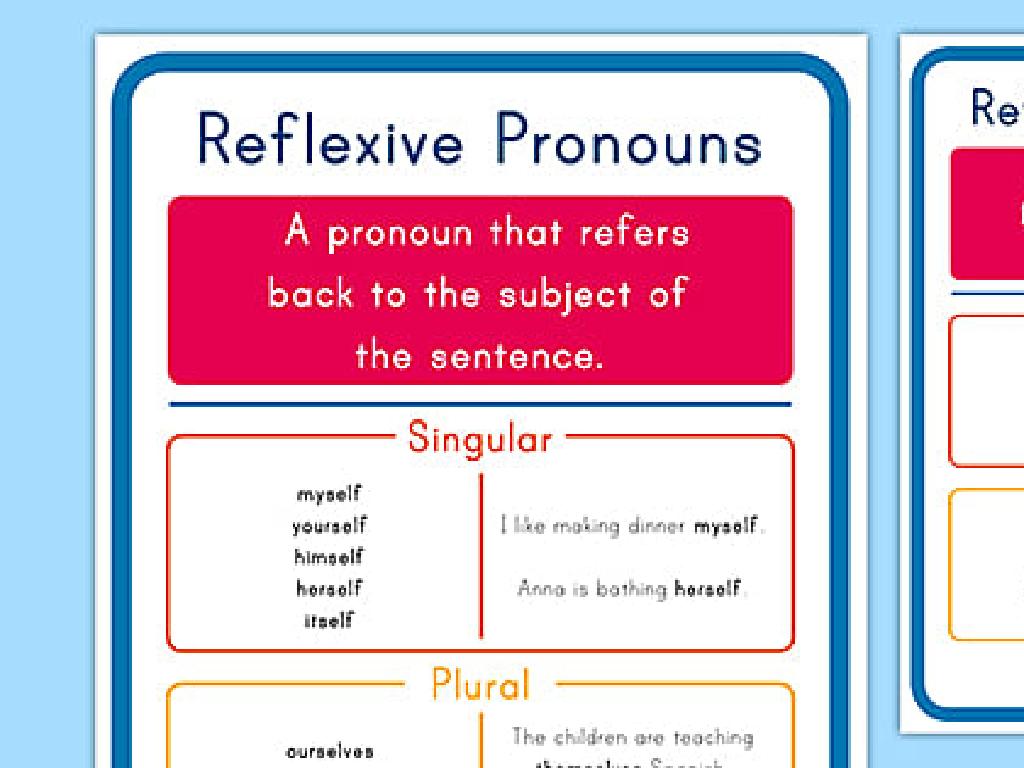Use Coordinating Conjunctions
Subject: Language arts
Grade: Fourth grade
Topic: Linking Words
Please LOG IN to download the presentation. Access is available to registered users only.
View More Content
Today’s Adventure: Coordinating Conjunctions!
– Discover what linking words are
– Linking words connect ideas and show relationships.
– Explore coordinating conjunctions
– Words like ‘and’, ‘but’, ‘or’ join sentences or ideas.
– Understand their role in sentences
– They help us combine thoughts for smoother communication.
– Learn why they’re important
– They make our sentences clearer and more interesting.
|
This slide introduces the concept of linking words, focusing on coordinating conjunctions, which are essential for constructing clear and coherent sentences. Emphasize that linking words help us connect ideas and show the relationship between them. Coordinating conjunctions like ‘and’, ‘but’, and ‘or’ are used to join words, phrases, or independent clauses. Explain that these conjunctions help in combining thoughts, which makes communication smoother and more effective. Highlight the importance of these words in making sentences more engaging and easier to understand. Encourage students to come up with their own sentences using coordinating conjunctions to reinforce their understanding.
Coordinating Conjunctions: Meet the FANBOYS
– What are Coordinating Conjunctions?
– They link equal parts of a sentence, like two ideas.
– Meet the FANBOYS
– FANBOYS: For, And, Nor, But, Or, Yet, So
– Joining equal parts of a sentence
– They can connect words, phrases, or whole clauses.
– Examples in sentences
– ‘I like apples, but my sister likes oranges.’
|
This slide introduces the concept of coordinating conjunctions to fourth-grade students. Coordinating conjunctions are the glue that holds equal parts of a sentence together. The acronym FANBOYS helps students remember the seven coordinating conjunctions: For, And, Nor, But, Or, Yet, So. Explain that these words can join single words, phrases, or even complete sentences that have equal grammatical structure. Provide clear examples for each conjunction in simple sentences. Encourage students to come up with their own sentences using FANBOYS to solidify their understanding. The goal is for students to recognize and use these conjunctions to create compound sentences and improve their writing fluency.
Coordinating Conjunctions: ‘And’ & ‘But’
– ‘And’ joins similar ideas together
– Like ‘I like apples and oranges.’
– ‘But’ highlights a contrast
– For example, ‘I like apples but not bananas.’
– Crafting sentences with ‘And’ & ‘But’
– Practice makes perfect
|
This slide introduces the use of ‘And’ and ‘But’ as coordinating conjunctions in sentence construction. ‘And’ is used to connect words or groups of words that are similar or related, while ‘But’ is used to show a contrast between words or groups of words. Encourage the students to think of their own examples where they might use ‘And’ to add information or ‘But’ to show a difference. For the class activity, have students create sentences using both ‘And’ and ‘But’ to reinforce their understanding. Provide guidance and feedback as they share their sentences with the class. This exercise will help solidify their grasp of combining and contrasting ideas in sentences.
Using ‘Or’ & ‘Nor’ in Sentences
– ‘Or’ offers a choice between options
– Do you want an apple or an orange?
– ‘Nor’ links two negative possibilities
– He neither likes to swim nor to cycle.
– Practice creating sentences
– Share your examples in class
|
This slide introduces the coordinating conjunctions ‘or’ and ‘nor’, which are used to connect words and phrases in a sentence. ‘Or’ is used to present options or alternatives, while ‘nor’ is used to connect two negative alternatives. For the class activity, students will practice using these conjunctions by creating their own sentences. Encourage them to think of different scenarios where they have to make choices or combine negative statements. Provide guidance on sentence structure and ensure they understand that ‘nor’ is typically paired with ‘neither’ in a sentence. After the activity, ask students to share their sentences to reinforce their understanding and to learn from each other’s examples.
Coordinating Conjunctions: ‘Yet’ & ‘So’
– ‘Yet’ shows contrast
– Use ‘yet’ to show something surprising, like ‘I was hungry, yet I didn’t eat.’
– ‘So’ indicates a result
– ‘So’ is for outcomes, like ‘I studied hard, so I passed the test.’
– Crafting sentences with ‘Yet’
– Using ‘So’ in sentences
|
This slide introduces the coordinating conjunctions ‘yet’ and ‘so’ to the students. ‘Yet’ is used to introduce a contrasting idea that is often unexpected. For example, ‘She is small yet strong.’ On the other hand, ‘so’ is used to show the result of something. For example, ‘It was raining, so we stayed indoors.’ Encourage the students to come up with their own sentences using ‘yet’ and ‘so’ to demonstrate their understanding. You can also provide additional examples and have the class identify the contrast and result in each case. This exercise will help solidify their understanding of how these conjunctions link ideas within a sentence.
Coordinating Conjunctions in Action
– Combine sentences with conjunctions
– Use FANBOYS (for, and, nor, but, or, yet, so) to connect ideas
– How conjunctions change meaning
– ‘I like apples, but I love oranges.’ vs ‘I like apples, and I love oranges.’
– Group activity: Comic strip conjunctions
– Fill in comic strips with suitable conjunctions to link sentences
|
This slide introduces students to the use of coordinating conjunctions to link sentences and ideas. Start by explaining the acronym FANBOYS, which stands for the seven coordinating conjunctions. Provide examples of sentences combined with different conjunctions to illustrate how the meaning can change depending on the conjunction used. For the group activity, distribute comic strips with empty speech bubbles and have students work in groups to fill them in using appropriate conjunctions. This will help them understand the practical use of conjunctions in writing. The teacher should circulate to provide guidance and ensure that students are using the conjunctions correctly. Possible variations of the activity could include creating their own comic strips or rewriting a short story using different conjunctions to change the meaning.
Let’s Play: Conjunction Matching Game
– Learn about coordinating conjunctions
– Coordinating conjunctions connect words, phrases, or clauses
– Find sentence pairs for conjunctions
– Look for sentences that could logically connect
– Match sentences with the right conjunction
– Use FANBOYS: for, and, nor, but, or, yet, so
– Get ready to play and learn!
|
This interactive game is designed to help students understand the use of coordinating conjunctions (FANBOYS) in linking sentences. Provide students with pairs of sentences and have them determine the appropriate coordinating conjunction to connect them. For example, one pair could be ‘I like to swim.’ and ‘I like to run.’ Students would then connect these with ‘and’ to form ‘I like to swim and I like to run.’ Encourage students to explain why they chose a particular conjunction. This activity will reinforce their understanding of conjunctions and how they can change the relationship between sentences. Prepare several sets of sentence pairs for the activity, ensuring a mix of conjunctions is used.
Class Activity: Conjunction Creation!
– Write a story using FANBOYS
– Include For, And, Nor, But, Or, Yet, So in your story
– Pair up for brainstorming
– Two heads are better than one! Share ideas.
– Collaborate on your story
– Work together to make a creative story
– Present your story to the class
– Practice public speaking by sharing your story
|
This activity is designed to help students understand the use of coordinating conjunctions (FANBOYS) in a fun and interactive way. By working in pairs, students can collaborate and come up with creative ways to incorporate ‘For, And, Nor, But, Or, Yet, So’ into a short story. This exercise will enhance their understanding of how conjunctions connect words, phrases, and clauses. Teachers should monitor the pairs for participation and guide them in story development. Possible variations of the activity could include creating comic strips, drawing scenes from their stories, or even acting them out. The presentation of their stories will help students practice public speaking and boost their confidence.
Conjunction Junction: Homework Time!
– Recap: Why conjunctions matter
– Homework: Craft 10 unique sentences
– Include ‘for’, ‘and’, ‘nor’, ‘but’, ‘or’, ‘yet’, ‘so’ in sentences
– Use various coordinating conjunctions
– Practice is key to mastery!
– The more you use them, the better you’ll get!
|
As we wrap up today’s lesson, remind students of the role coordinating conjunctions play in connecting ideas and making sentences flow smoothly. For homework, they should write 10 sentences, each using a different coordinating conjunction. This will help reinforce their understanding and application of these linking words. Encourage creativity and remind them that regular practice is essential for improving their writing skills. In the next class, we can review some of their sentences to celebrate their efforts and clarify any confusion.






